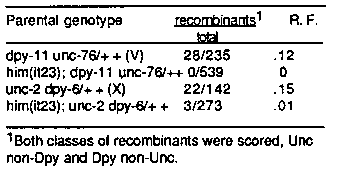Worm Breeder's Gazette 10(1): 104
These abstracts should not be cited in bibliographies. Material contained herein should be treated as personal communication and should be cited as such only with the consent of the author.
The process of meiosis consists of five major chromosomal events: replication, homologous pairing, recombination, resolution, and disjunction. Isolation and analysis of meiotic mutants will provide insights into the molecular mechanisms of these events. We have identified and partially characterized mutations in a gene that plays a role in recombination and disjunction in both male and hermaphrodite germ lines. Five mutations(it13, it21, it23, it44ts, it52) at this locus, initially called mel-4, were identified in a screen for maternal-effect lethal mutations on chromosome II (WBG 9 (3), 88). Although we have not yet identified an amber mutation, the frequency with which these alleles were recovered (3.6x10+E-4) suggests that a strong allele, it23, should be indicative of the null phenotype. Two major characteristics of the mutant phenotype are low percentage of viable embryos and high percentage of males among the viable embryos ( see Table 1). Based on these data we suggest that this locus be classified as him (high incidence of males). [See Figure 1] Hodgkin et al.(Genetics 91, 67) have shown that him mutations exhibit increased nondisjunction. Because it seemed likely that an increased rate of nondisjunction was responsible for the low viability and the high percentage of males from him(it23) hermaphrodites, we used genetic and cytological experiments to examine this possibility. To determine if the self-progeny males were sexually transformed hermaphrodites(XX) or 'true' males(X0), we constructed the strain him( it23) unc-4 II: dpy-8/lon-2 X and scored the phenotypes of the F1 self- progeny males. No wild-type males were produced indicating the males were X0 and were probably arising by X chromosome nondisjunction. Dpy hermaphrodites (XXX?) were also present among the surviving progeny. Genetic evidence for autosomal nondisjunction was obtained by mating him(it23) males to a marker strain (dpy-10 he results of this mating were consistent with high frequency autosomal nondisjunction and indicated that both germ lines were equally affected. Nondisjunction could lead to low viability because it would cause the formation of aneuploid gametes. Combinations of these gametes would produce aneuploid, and presumably inviable, embryos. To determine the ability of the male (paternal) germ line to produce viable embryos, and thus normal gametes, the frequency of viable embryos from the cross was calculated by the following ratio: # cross progeny / (# cross progeny + unhatched embryos). Comparing this frequency (.18) to the frequency of viable him ( it23 ) hermaphrodite self progeny (.03) indicates that both germ lines are equally affected (.18(2)=.032). Proof that the maternal chromosomes are affected and further support for nondisjunction were provided cytologically. him( it23) hermaphrodites were stained with DAPI and chromosomes were counted in the first two oocytes distal to the spermatheca for both gonad arms. Wild type oocytes are in diakinesis, a meiotic stage prior to resolution (Nigon and Brun,1955), and the six tetrads can be easily counted. The results (Table 2) indicate that most him(it23) chromosomes are unpaired at this stage. To determine if this phenotype was characteristic of other him mutations several of them [him-3(e1147), him-5(e1467, e1490), him-6(e1104, e1423), and him-12( it47)] were also examined cytologically (Table 2). The disruption of pairing in these him mutations is consistent with the severity of their phenotypes (see Hodgkin et al.). [See Figure 2] The data for him(it23) indicate that the mutation acts at a meiotic event prior to disjunction. One possibility is that the first three meiotic events (replication, pairing, and recombination) occur normally, but resolution occurs precociously. In this case recombination frequencies should be normal. Recombination frequencies were tested in him(it23) for an autosome (V) and the X. him(it23) hermaphrodites with chromosomal markers in cis were constructed and recombination frequencies recorded. [See Figure 3] Recombination is greatly reduced in the him(it23) background, suggesting a defect in pairing or in recombination. Preliminary studies at the EM level indicate that synaptonemal complex is present in him(it23) oocytes during the early stages of meiotic prophase, suggesting that him(it23) affects recombination, leading to an absence of chiasmata and thus to unpaired chromosomes at diakinesis. Further analysis of this new him locus should provide insights into the mechanism of homologous pairing and/or recombination and may provide new information about the relationship between prophase pairing and chromosome disjunction.


